Delicate topics: grades and their distribution have meaning
I have always argued that "qualified faculty
implementing outlines based on student learning outcomes produce
trustworthy grades." I know grades are not a form of direct learning
assessment.
The statistics final,
http://www.comfsm.fm/~dleeling/statistics/s53/farawayrainbow.html, is
comprehensive with each major area of the course and its outcomes
tested. This is a difficult final in a difficult course in a subject
area that is arguably the most problematic for the students,
mathematics. I would argue that there is meaning in the distribution
of scores for this final.

The final actual had a theoretically possible maximum of 48 points, but
no one scored higher than 47. The lowest score was 14. The distribution
above is not a "grade" distribution, just a distribution by raw scores.
I would argue that the distribution means that the final, as difficult
as it was, was achievable and attainable for the students.
The distribution of "grades" on the final, using the traditional 90%,
80%, etc., is as shown below:

This is a flatter or more uniform distribution than the overall raw
score distribution, but again I would argue that the students are
attaining and achieving. They are performing rather strongly on a
difficult final in a difficult course.
I share this because I, like many others, often speak of the weaknesses
and inabilities of our students. Yet 55 of them have tackled this final
achieving a coursewide average of 73%. No, this is not a student
learning outcome, although I could, with a two thousand, six hundred
and forty item analysis effort tell you exactly what each one can and
cannot do against the outcomes on the outline. If the average had not
existed, statisticians would have invented it. There is instant
meaning in 73% with a 24% coefficient of variation that a 48 by 60 grid
of "achieved/not achieved" will never convey.
Now that I wandered out onto the thin and unpopular ice of defending
grades, I thought I might jump up and down until I fall into the icy
water. And again, I am not denigrating the need to assess learning
outcomes. I just do not want to throw out the baby with the bath
water. Having argued that grades are an inferential measure of
learning, I intend to skate on the thinnest of all possible ice, and
then maybe not come to work for a few years until the anger abates:
grades as a very crude and dangerous inferential measure of my
performance.
Before I am led to the slaughter of the evil people, remember that I
fully believe that former chair Steve Blair was correct that as soon as
grades are used to measure anything, slippery slopes develop that lead
to artificial and unsupported grade inflation. Want to improve the
"promotion" rate? Give away A's, B's, and C's. Please, look at the
material in statistics and the final before leveling this charge at me:
this is a tough course with low rates of "promotion." The statistics
final is no giveaway, nor is the course.
A student came into my office this week. He had achieved a 75% (36/48)
on the final examination and 71.3% overall in my course. He seems to be
a capable fellow, nice enough, and not one who seems given to outright
lying. I asked how he was doing in his other courses, and he noted with
sadness he had failed an important course. I asked what had happened
and he said he was not a graduating student. I was puzzled, because I
knew he was not on the graduation list. I asked him for clarification
and he said, "Graduating students get a D, all others get an F [from
that instructor]." I said, "That cannot be, there is no such grading
system at the college." I asked if he was sure, and he said yes. He
said there wasn't really any chance for a student to pass. He felt that
the teacher was simply not capable of explaining things, and that the
instructor is, essentially, unfit for the profession.
I know we hate to be evaluated by students, but then car companies
probably are not actually fond of being evaluated by drivers in
Consumer's Reports. And I am not arguing that we go beyond our current
system, although no one gave me the faculty evaluation forms this
term. Usually the director of academic programs does this, in most
terms I do this in absence of the forms as I have copies on my web
site. But in the crush of the end of the term, I forgot.
Still, I would argue that triangulation is possible, dangerous, and,
like a too sharp machete, to be wielded gently and with extreme care.
If students give thoroughly negative ratings where even capable
students feel they could not pass no matter what effort they exerted,
and all of the grades are D's and F's, then maybe it is time for that
instructor to look for new ways to communicate the material, new
approaches in the classroom, making themselves more approachable and
more available...
Back in the world of statistics, the golden goal is usually to have
things distribute in nice symmetrical piles which we call "normal
distributions." I have no idea why this is good, it simply is what
statisticians look for in life. David was careful to show that each
question on the entrance test was effectively being responded to in a
"normally distributed" fashion. I do not do anything to cause my
students to distribute normally, and they do not always do so. I was
pleased this term, however, when my statistics course distribution did
just this:

If I am "hard to find" this week, it may be my fear of reprisals and
attacks for having touched on some delicate topics. I would apologize
at the end of this email if I have offended anyone, but I believe I
teach a tough and rigorous course. I find ways to help my students
learn the material and show capacity to perform the material. Our
students are underprepared and weak, and I am looking at the better
students when I stand in MS 150, still, our students can perform.


